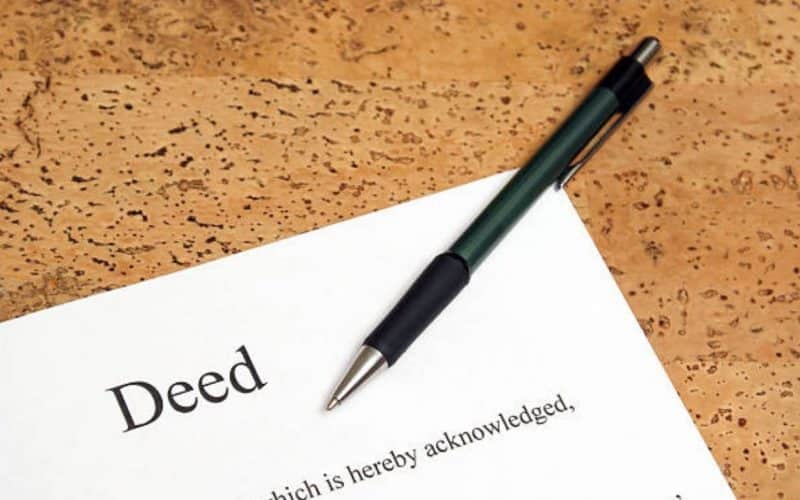A grant deed is a document that shows that a change of ownership has occurred during a sale. It is “the physical representation of the transfer of ownership.” The deed will show the names of the seller and buyer of the property and must have the signature of at least the seller of the property to confirm the transfer of ownership.
A deed typically includes the following pieces of information:
- A description of the real estate involved
- The names of the respective parties
- The signature of the person transferring the real estate
In this article, you will learn everything you need to know about property deeds to ensure you feel comfortable whenever you are doing a property transaction.
Different Types of Deeds
Depending on the nature of the transaction and the history of the property, the deed attesting to the purchase or sale of your home may vary. Here are the most common types of acts:
- Warranty deed.
- Grant deed.
- Quitclaim deed.
- sale deed.
#1. Warranty deed
A warranty deed is the most common deed that you will encounter in a standard home sale. “It’s the one that offers the best and the best protection for the buyer,” says Bonner. Title companies use this act in transactions when it can be confirmed that the ownership of the property is free from discrepancies, privileges, or any other issues. It also shows the buyer that the seller is the correct owner with the right to sell the property.
#2. Grant deed
A grant deed, which can also be called a deed of concession, is still used with title insurance, but it provides a limited warranty of unencumbered property. With the grant deed, the title company is able to confirm that the seller has not experienced any ownership discrepancies or encountered other ownership issues, but the title company is unable to make the same guarantee before the purchase of the property by the seller.
#3. Quick claim Deed
A quick claim is a simple deed often used when an individual transfers ownership of a piece of property to a person she knows. These deeds can be drawn up by an attorney or even by the seller, and they offer no guarantee that the noted seller holds the title to the property.
#4. Sales deed
This type of deed is often used in a foreclosure auction or bank sale of a piece of real estate, and the nature of the deal makes it harder (if not impossible) to guarantee that there are no other claims of ownership.
What are Grant Deeds?
A deed of ownership is a written and signed legal instrument that is used to transfer ownership of real estate from the previous owner (the settlor) to the new owner (the beneficiary). Historically, real property was transferred through a ceremonial act known as the “livery of referral”. In this act, the person transferring the land handed over a twig or sod from the land to the person taking delivery of the land.
A verbal or written statement often accompanied the gesture, although it was the livery of the seizure that legally transferred title to the property. Today, the title of real estate is conveyed by a done paper.
A person who is competent to enter into a valid contract is considered competent to be a grantor. The licensor and the concessionaire must be identified in such a way as to be verifiable. The property must be adequately described. The transport slogans must be present. All Standard Form Deeds include the necessary legal language that actually transfers ownership.
The deed must be signed by the settlor (s) if the property belongs to more than one person. The beneficiary or a person acting on their behalf must be given the deed in a legal way. They must be accepted by the beneficiary. Most of the time, the concessionaire will accept the deed, but in some cases, the concessionaire may refuse to accept the deed.
Essential Components of Grant Deed
Even though each state has its own rules, most acts must have a few key parts in order to be legal:
- They must be written. While most deeds are completed on printed forms, there is no legal requirement that a specific form is used as long as the essentials are included.
- The grantor must have the legal capacity to transfer the property and the concessionaire must be able to receive the concession of the property.
- A person who is competent to enter into a valid contract is considered competent to be a grantor. The licensor and the concessionaire must be identified in such a way as to be verifiable.
- The property must be adequately described. The transport slogans must be present. All Standard Form Deeds include the necessary legal language that actually transfers ownership.
- The deed must be signed by the settlor (s) if the property belongs to more than one person. The deed must be legally delivered to the beneficiary or to a person acting on their behalf.
- They must be accepted by the beneficiary. Typically, deeds are accepted by the concessionaire, but in certain circumstances, the concessionaire may refuse delivery of the deed.
Grant Deed California
California law allows for the use of three different types of deeds to transfer title to real estate. A grant deed is an intermediate-level deed because it guarantees the title of the property more than a quitclaim deed but less than a warranty deed.
Grant Deed Form
For a deed of concession to be legal, it must include the name of the new owner, the signature of the person giving away the title, and a legal description of the property being given away.
How to Write a Grant Form
You can use a free online template to create your grant document or write your own from scratch. In either case, it’s a good idea to seek legal advice from a lawyer who can make sure the document is valid.
Each grant act must include the following information:
- Name of grantor Name and address of the beneficiary
- Description of the beneficiary (e.g. single man, husband, and wife, roommates)
- A person who requested the deed of concession
- Address of the property being transferred
- The legal description of the property (lot number)
- Original title number for the property tax identification number or expert’s plot number (APN)
- Tax-exempt status
A grant deed should be filed with your county assessor’s office.
Grant Deed vs Deed of Trust
A grant deed and a deed of trust are legal documents that may sound similar but are not in any way the same.
Grant deed
A grant deed is used to transfer real estate ownership from one person to another. The transfer of ownership can relate to a complete piece of real estate or only part of the real estate. Most of the time, deeds of concession are used when a buyer and seller do not know each other.
A grant deed can also be used to transfer ownership as a gift. When a deed of concession is used, the person transferring the property rights promises the person receiving the property rights that these rights have not previously been transferred to someone else.
A trust deed
A trust deed is used when a debt is paid back by three different people. The first part is a real estate owner or buyer who borrows money that can be used for any purpose. The borrower signs a trust deed, which gives legal ownership of his property to a third party, as a guarantee that he will pay back the loan.
Different Between Grant Deed and Deed of Trust
So what is the difference between a grant deed (deed of concession) and a deed of trust? A grant deed is a legal document that allows the grantor to give the beneficiary ownership of the real estate. It is given to a real estate buyer by the seller as an assurance that the property in question is not owned by anyone else, free from hidden liabilities, and in an agreed-upon condition.
A trust deed, on the other hand, is used in several states to secure real estate property presented as security for a loan. It legally gives the property’s title to a trustee, who is the lender, until the borrower, who is the trustee, pays back the loan in full.
Grant Deeds vs Quitclaim Deeds
A is the most preferable deed for a buyer. Grant deeds transfer the property with a guarantee that the buyer will not be responsible for any unknown ownership claims that may be brought in the future. Rather, the seller will be responsible in the event a claim is made against the property.
However, a quitclaim deed does not contain any guarantee against future ownership claims. It only shows the seller’s interest as it is, even if there are unknown claims to ownership. A quitclaim deed makes it clear to the buyer that the seller makes no claims about the marketable title. We see quitclaim deeds used when the property is being transferred from two joint owners to one.
Grant Deed vs Warranty Deed
The deed describes a legal document that proves a real estate transfer. Deeds of warranty and concession promise different levels of legal protection to the buyer based on how much the seller guarantees. If the seller then breaches one of these commitments, the concessionaire can sue the grantor.
What is the Most Effective Kind of Deed?
A universal warranty deed offers better protection to real estate buyers than any other type of deed. While it is the best action for the grantee, it exposes the grantor to the highest liability. Several covenants normally bind the grantor, including:
- The covenant of seisin—the grantor guarantees that they possess the property and have the legal authority to convey it.
- The covenant against encumbrances—the grantor guarantees that the property is free of liens or encumbrances.
- The covenant of peaceful enjoyment—the grantor secures the grantee’s title against third-party claims.
What is the Difference Between a Grant Deed and a Quitclaim Deed?
Property is transferred between sellers and buyers via grant deeds and quitclaim deeds. Buyers are better protected by grant deeds than by quitclaim deeds. A grant deed grantor guarantees that the property was free of encumbrances while they held the title (except as noted in the deed).
A quitclaim, on the other hand, contains no covenants or warranties and simply conveys the grantor’s interest (if any) when the deed is given. A quitclaim deed provides no benefit to the grantee if the grantor has no interest in the property.
What is the Difference Between a Grant Deed and a Mortgage?
Grant deeds and mortgages are not the same things. Grant deeds (together with other types of deeds) are used to transfer ownership of real estate from a seller to a buyer. A mortgage, on the other hand, is a conditional transfer or pledge of real estate as security (collateral) for debt payment.
Conclusion
The transfer of a title deed is made by an authentic instrument. Certain important parts of the act must be there for it to be legal. Different acts offer different levels of protection to the beneficiary, and the obligations of the grantor are determined by the form of the act. Since deeds are important legal documents that affect interests and property rights, a qualified real estate lawyer should be consulted for any transaction that involves them, like closing on a home purchase.






